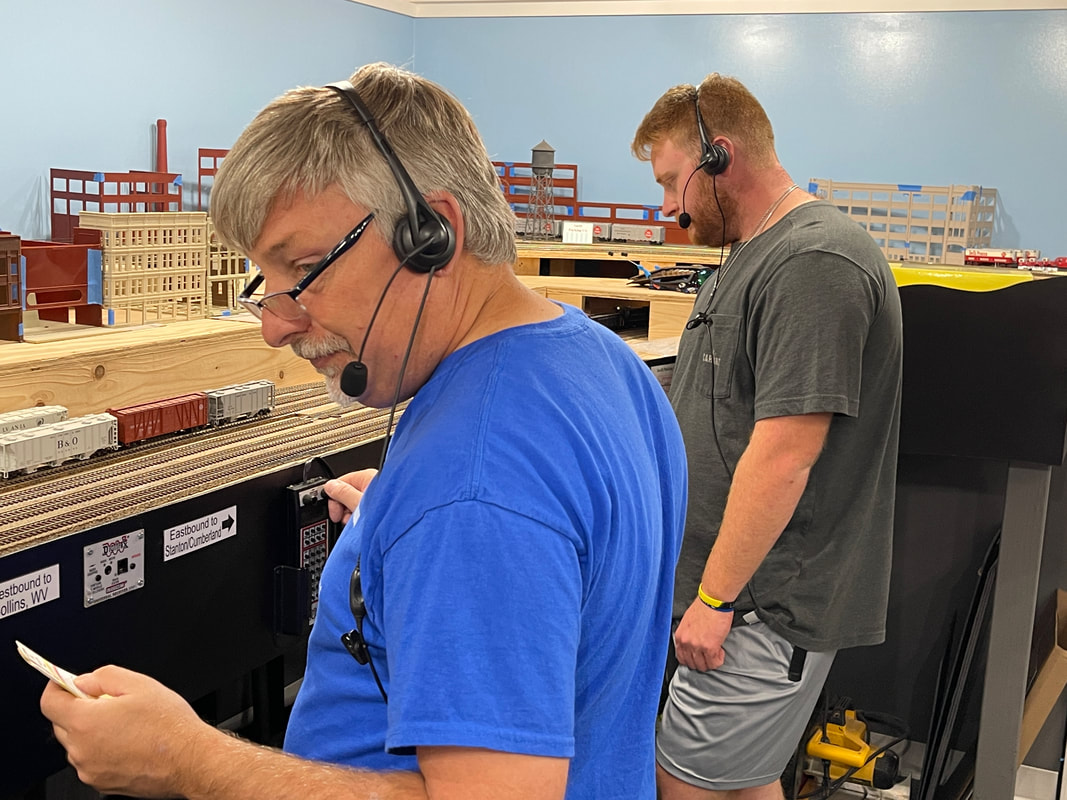Operations on the C&OV
While my first love in the hobby will always be layout construction, operating it with a group of close friends as a miniature transportation system is a very close second. All of the members of my crew, including myself, are newbies when it comes to operations. But it has been great fun learning the ropes together in a laid-back, congenial atmosphere. For us, it's as much about the fellowship as anything else. On this page, I would like to share the operating scheme of my layout and the systems that have been put in place to make it come to life.
As mentioned on the previous page, there are five hidden staging yards that feed the traffic on and off of the layout, plus one hidden storage yard not used during op sessions. On the lower (C&O) mainline, these include Cincinnati, OH, Ashland, KY, and Lexington, Ky. The Lexington staging yard simulates transfer runs between the L&N and C&O. The upper (C&OV) mainline has staging for Middlesboro, KY and Columbus, OH. To monitor the movement of trains in these hidden staging yards, I installed nine night-vision surveillance cameras at the entry and end points of each yard. The images are displayed on a TV next to the Dispatcher's desk and can be shown individually or in any number of split screen variations. I created a sequence timetable with 12 scheduled trains, four of which are passenger consists. Depending on traffic density, there may be Extra Trains run as well. Crew members sign up for job assignments on a call board when they arrive.
The Yardmaster controls Colton Yard through a central panel which uses state-of-the-art touch toggles. He has a list of all scheduled trains that gives color-coded instructions for blocking cars. The Yardmaster dictates the movement of all traffic within yard limits. Now that the turntable is operational, we may add a hostler position to move and service motive power. We use 2-way radios with headsets for communication. I love hearing the prototype chatter between crew members during our sessions! The movement of traffic is controlled and monitored through the use of JMRI Panel Pro on my Mac. While road crews have the authority to use a combination of ground throws and touch toggle panels (for hard to reach switches) along the mainlines, the Dispatcher controls turnouts within staging yards, as well as Union Station, from the computer. Using JMRI with the surveillance cameras has removed all of the guess work and hazards associated with hidden staging. Panel Pro also allows you to create moveable train "markers" which is used to monitor the location of trains. As crew members "OS" their locations to the Dispatcher, he advances the related marker through the schematic. This assists in planning meets and alleviating traffic congestion. As we gain experience, we may eventually add a fast clock and timetable to enhance operations.
For car forwarding, I use car cards and waybills. I purchase the car cards from Micro-Mark, but prefer to add printed labels instead of writing the information by hand. I make my own waybills using a software program from Shenandoah Software. The waybills are color coded by destination and staging route. This not only assists the Yardmaster in blocking cars, but also helps me tremendously in restaging the layout between sessions. I also created Train Order cards to go in the boxes with specific instructions for operators. Each town and major switching area has a card box with compartments for each track, a sorting shelf for clipboards and cards, and a tube cut from PVC pipe for holding uncoupling picks and pencils. As I mentioned earlier, three of the towns have small touch toggle panels for turnouts that are difficult to reach. Each town also has a small digital timer with an instruction label for passenger station stops, as well as throttle holders and Digitrax panels. In areas where there are industries with multiple tracks, I added labeled track diagrams to avoid operator confusion. My goal was to create a very contemporary, sleek looking fascia. As a result, I chose to paint the fascia boards black to match the track lighting and create a very professional-looking presentation.
As operators are called on duty, they receive a clipboard with information specific to their train. Using double-sided tape, I added a clear plastic pocket which receives an Engine Order card giving decoder information for the assigned locomotive(s). They also receive their bundle of car cards which are held together with a binder clip in a box for the originating staging yard track. The binder clip is labeled with the train number to avoid confusion. Operators of trains that originate in Colton Yard are given their paperwork by the Yardmaster. Once a crew member completes their run, the bundle of car cards is placed in the appropriate card box and the clipboard left on the shelf. Passenger trains simply have a laminated card that lists station stops, consist information and decoder functions.
A complete session lasts around two hours and represents one 8-hour trick. We alternate between morning (4:00 am to 12:00 pm) and evening (12:00 pm to 8:00 pm) tricks. Eventually, this will allow us to bring in the extra challenge of night operations. Because the track lights have dimmable LED bulbs, I could install a timer control to simulate sunrise and sunset during the sessions. One of the standards I have on the C&OV is that every structure will have interior lighting. This would add an extremely cool and exciting enhancement to the experience. In the meantime, we will continue to enjoy operating the layout on a regular basis. It truly does bring my creation to life!



